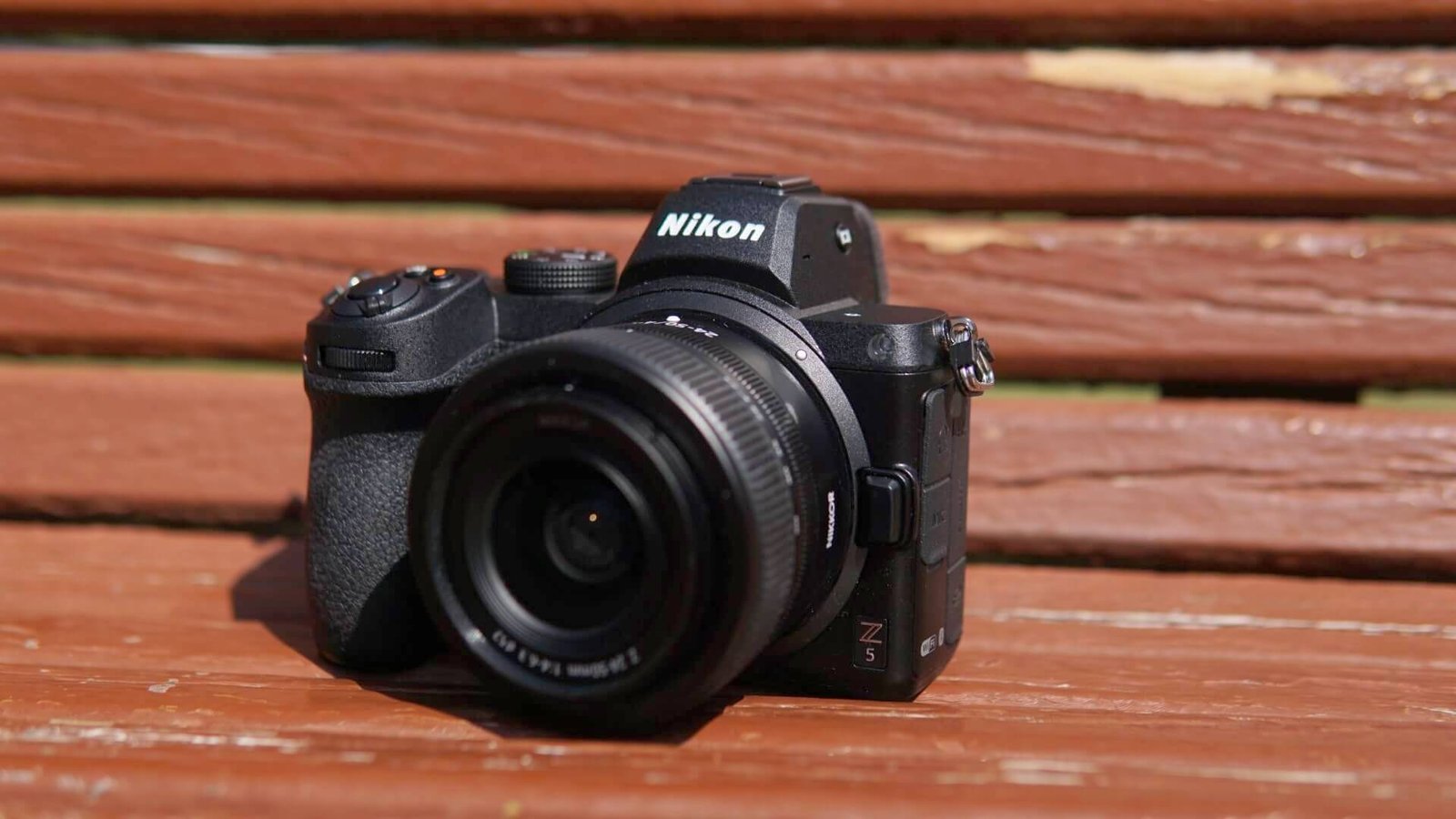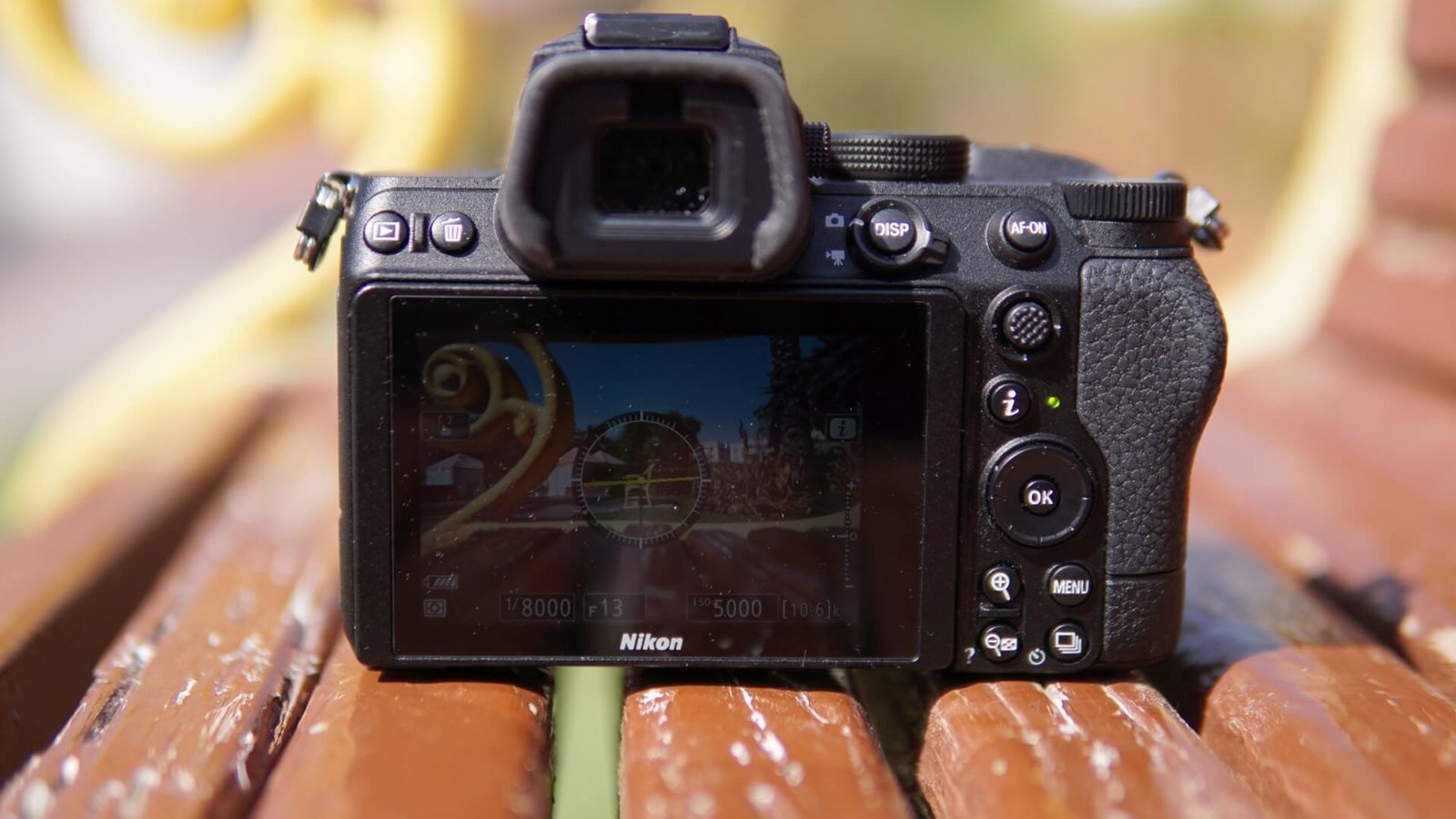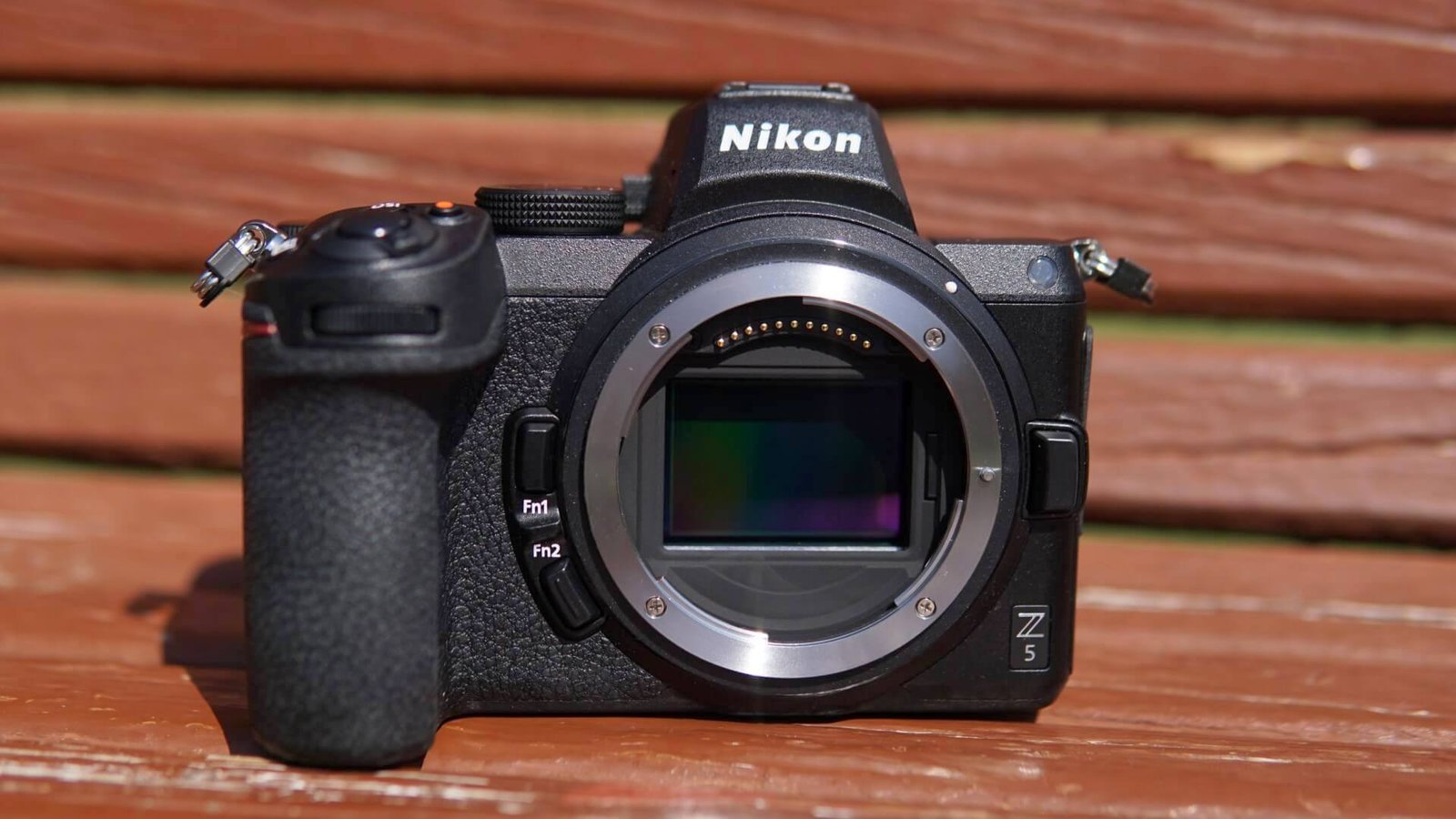It’s been two years since Nikon entered the mirrorless full-frame market with the Nikon Z6 and the Nikon Z7 cameras. The company later also introduced the APS-C based mirrorless camera called the Nikon Z50. While these cameras did deliver great performance, there was the entry-level full-frame segment that needed to be fulfilled. Nikon recently announced its latest entry-level full-frame mirrorless camera called the Nikon Z5 and we got a chance to review the product.
Design
While Nikon Z6 and Nikon Z7 are the flagship products meant for professionals and photography enthusiasts, the Nikon Z5 is the company’s latest entry-level full-frame mirrorless camera designed to offer pro-level features at a slightly affordable price tag. The Nikon Z5 features a design that is almost similar to that of the Nikon Z6 camera, including internal specifications which we will cover at a later part. The Nikon Z5 features a physical dimension of 134 x 100.5 x 69.5mm. It is barely larger in size than the Nikon Z6. That said, both the new Nikon Z5 and the Z6 camera weighs 675g. The Nikon Z5 also shares a similar chassis that features a magnesium alloy frame. However, the magnesium alloy is only present on the front and top portion of the new camera. That said, the Z5 is a weather-sealed camera that can resist dust, dirt, and moisture, allowing to operate in rough situations where the photographer may go to capture images or videos on a rainy day, a sunny day at the beach, and more. Nikon claims that the moving parts and also the buttons are also weather-sealed. This is interesting since dust always finds its way to settle on the edges of any button and it gets annoying when trying to get rid of them.
 On the front side of the camera, you will find the dial on the grip that can be used to adjust different settings such as the ISO. It’s a common location where many camera manufacturers prefer to place a dial. Nikon has placed two function buttons that sit right next to the Z mount for quickly accessing your favorite and desired settings. You can assign your favorite functions to the Fn1 and Fn2 buttons. The buttons can be accessed using your middle or index finger while holding the camera. Do keep in mind that Nikon has already assigned the Fn1 for adjusting white balance and Fn2 as an autofocus area selector. Of course, this can be changed from the custom controls on the camera menu system. There is also the lens release button that helps to eject the lens when you plan to switch the glass. You can also see the illuminator on the front side (right) that supports the autofocusing performance of the camera.
On the front side of the camera, you will find the dial on the grip that can be used to adjust different settings such as the ISO. It’s a common location where many camera manufacturers prefer to place a dial. Nikon has placed two function buttons that sit right next to the Z mount for quickly accessing your favorite and desired settings. You can assign your favorite functions to the Fn1 and Fn2 buttons. The buttons can be accessed using your middle or index finger while holding the camera. Do keep in mind that Nikon has already assigned the Fn1 for adjusting white balance and Fn2 as an autofocus area selector. Of course, this can be changed from the custom controls on the camera menu system. There is also the lens release button that helps to eject the lens when you plan to switch the glass. You can also see the illuminator on the front side (right) that supports the autofocusing performance of the camera.
 Looking at the top portion of the camera, you will find that the right side is quite populated with buttons and dials. Nikon jammed both the main dial to change the modes and the command dial next to each other. The main dial that sits next to the viewfinder and the command dial is fixed next to the handgrip. There is also a little 6-hole speaker that sits in between the main dials. There is also the power switch that doubles as the trigger shutter button. It is complemented with a video record button, the ISO button, and the exposure button. For adjusting the ISO, you will need to first press and hold the ISO button and then turn the dial that is located on the front portion of the camera. I was able to easily reach the video button with my index finger when I wanted to record at will. The main dial gives you options such as the Auto mode, Manual, Shutter priority auto, Aperture-priority auto, and the user settings based U1, U2, and U3 modes.
Looking at the top portion of the camera, you will find that the right side is quite populated with buttons and dials. Nikon jammed both the main dial to change the modes and the command dial next to each other. The main dial that sits next to the viewfinder and the command dial is fixed next to the handgrip. There is also a little 6-hole speaker that sits in between the main dials. There is also the power switch that doubles as the trigger shutter button. It is complemented with a video record button, the ISO button, and the exposure button. For adjusting the ISO, you will need to first press and hold the ISO button and then turn the dial that is located on the front portion of the camera. I was able to easily reach the video button with my index finger when I wanted to record at will. The main dial gives you options such as the Auto mode, Manual, Shutter priority auto, Aperture-priority auto, and the user settings based U1, U2, and U3 modes.
 For those who may have used the Nikon Z6, you can see that there are some differences in the top portion of the Z5 design. For instance, Nikon did not implement a secondary screen on the Nikon Z5. On the contrary, the Nikon Z6 has a second LCD screen called the Control Panel on its top right side. Also, the main mode dial which is seen on the top right side of the Z5 was actually on the top left side of Z6. And except for the focal plane markings, there is nothing mounted on the top left side of the Nikon Z5. That said, the viewfinder portion does feature dual stereo microphones on either side of the device and also the obvious inclusion of the accessory shoe.
For those who may have used the Nikon Z6, you can see that there are some differences in the top portion of the Z5 design. For instance, Nikon did not implement a secondary screen on the Nikon Z5. On the contrary, the Nikon Z6 has a second LCD screen called the Control Panel on its top right side. Also, the main mode dial which is seen on the top right side of the Z5 was actually on the top left side of Z6. And except for the focal plane markings, there is nothing mounted on the top left side of the Nikon Z5. That said, the viewfinder portion does feature dual stereo microphones on either side of the device and also the obvious inclusion of the accessory shoe.
 Now let us take a look at the sides of the camera. On its left side are all the ports that are needed for extra connectivity. You get the headphone connector and the microphone port mounted vertically one above the other. Then comes the USB Type-C port that used for either connecting to a PC or for power charging, an HDMI port to connect to external displays, and the inclusion of an accessory terminal. There is also a little charging lamp to indicate the charging status of the camera. On the right side of the camera where the grip is located, you can easily pop-open the memory card slot that features a dual-slot configuration.
Now let us take a look at the sides of the camera. On its left side are all the ports that are needed for extra connectivity. You get the headphone connector and the microphone port mounted vertically one above the other. Then comes the USB Type-C port that used for either connecting to a PC or for power charging, an HDMI port to connect to external displays, and the inclusion of an accessory terminal. There is also a little charging lamp to indicate the charging status of the camera. On the right side of the camera where the grip is located, you can easily pop-open the memory card slot that features a dual-slot configuration. 
An interesting note to point out is that the Nikon Z6 camera only has one memory card slot that accepts the super fast CF express and XQD memory cards. While these memory cards feature fast read and write speeds, the cards were expensive and thicker in size than SD memory cards. What made things worse is that users could not use SD cards on the Nikon Z6. The new Nikon Z5 doesn’t come with a CF/XQD slot but instead comes with dual SD card slots that support UHS-II SDHC and SDXC cards. It’s a great welcome addition since there are many photographers who would prefer SD cards instead. And the inclusion of dual slots means they can take backups of all their shots on another memory card while they capture images or videos.
Looking at the rear side of the camera, you will first notice the 3.2-inch TFT tilting touchscreen monitor, along with the viewfinder that features an eyepiece of 1.27cm. The viewfinder comes with an OLED panel that features a 3690k-dot resolution. There is also a rubber eyecup that helps to enhance comfort while you see through the viewfinder. A diopter adjustment dial is also included to optimize the focus of the viewfinder that suits your vision. Nikon placed the playback button and the delete button on the left side of the viewfinder and above the display. On the right side of the rubber cup, you will find the DISP button that helps you switch instantly between image and video mode. While you can switch between image and movie modes, the DISP or Display Mode button can be pressed to showcase the camera parameters on the LCD screen and the viewfinder, in a simplified view, all parameter view, or the information screen.
 Then you will find the AF-ON button that lets you focus in the autofocus mode, and below the AF-ON button lies the joystick that lets you select the focus point while capturing images. This is a very important feature that is there in most full-frame cameras out there since it helps to adjust the focus points. The joystick also feels very comfortable on your thump, thanks to the textured surface of the sub-selector. You can also press and hold the selector to lock a focus point or an exposure. There is the i button to toggle the quick access menu that shows settings such as flash, AF coverage, white balance, file type, metering, stabilization, AF continuous or single-shot, etc. You can customize the order and settings under the Controls menu of the user interface. Below the quick access menu button are the directional buttons that simply lets you navigate through the user interface.
Then you will find the AF-ON button that lets you focus in the autofocus mode, and below the AF-ON button lies the joystick that lets you select the focus point while capturing images. This is a very important feature that is there in most full-frame cameras out there since it helps to adjust the focus points. The joystick also feels very comfortable on your thump, thanks to the textured surface of the sub-selector. You can also press and hold the selector to lock a focus point or an exposure. There is the i button to toggle the quick access menu that shows settings such as flash, AF coverage, white balance, file type, metering, stabilization, AF continuous or single-shot, etc. You can customize the order and settings under the Controls menu of the user interface. Below the quick access menu button are the directional buttons that simply lets you navigate through the user interface.
There is also a magnification + and – buttons to zoom in and out of images that you have captured while viewing them via the playback button. Interestingly, these buttons can also be used to zoom in and out during shooting. Along with the menu button, there is also the release button that lets you choose between single and continuous shooting modes. There is also the option of a self-timer that can be accessed with this button. This is a very convenient shortcut to use when we want to trigger the timer or the type of shooting mode, instead of navigating through the main menu or quick settings menu.
Specifications and Image Quality
Now we come to the internal specifications of the camera. While the Nikon Z5 packs a 24.3MP full-frame image sensor under its hood, the sensor is not a back-illuminated design as the one used on the Nikon Z6. It’s a front-illuminated full-frame image sensor, which is quite odd considering the fact that most of the modern full-frame mirrorless cameras come with a BSI sensor. Having a back-illuminated image sensor helps to achieve a better dynamic range and improved low-light capability. We didn’t have the Nikon Z6 to compare with the Z5 to judge the amount of difference in image quality. That said, it is a full-frame sensor that can capture a lot of light and information for great shots. Perhaps Nikon decided to use a front-illuminated sensor on the Nikon Z5 to distinguish itself from its premium cameras. That said, the Z5 does use Expeed 6 image processor that is also used on the Z6. The Expeed 6 chip can help to capture and generate high-quality images and videos with less noise. The Z5 also shares the same 5-axis image stabilization that is also present on the Z6, with up to 5-stops of shake compensation.
 With respect to sensitivity, the Z5 can adjust between ISO 100 and up to ISO 51,200. The full-frame image sensor with the aid of the Expeed 6 processor should be able to minimize the image noise when firing at high ISOs. What was disappointing is that the continuous burst mode can max out only up to 4.5fps. On the contrary, the Nikon Z6 can do up to 12fps. We wish the camera could have had at least 10fps or 8fps at most. So do not expect to capture fast-moving objects so easily. Speaking of which, the Z5’s image sensor features a 273-point hybrid autofocus detection system, consisting of both phase and contrast AF points. The phase-detection helps for the instant focusing on the Z5, followed by improved accuracy with the contrast AF points. Autofocus area modes include pinpoint, single-point, dynamic-area, wide-area in small and large, and auto-area AF mode.
With respect to sensitivity, the Z5 can adjust between ISO 100 and up to ISO 51,200. The full-frame image sensor with the aid of the Expeed 6 processor should be able to minimize the image noise when firing at high ISOs. What was disappointing is that the continuous burst mode can max out only up to 4.5fps. On the contrary, the Nikon Z6 can do up to 12fps. We wish the camera could have had at least 10fps or 8fps at most. So do not expect to capture fast-moving objects so easily. Speaking of which, the Z5’s image sensor features a 273-point hybrid autofocus detection system, consisting of both phase and contrast AF points. The phase-detection helps for the instant focusing on the Z5, followed by improved accuracy with the contrast AF points. Autofocus area modes include pinpoint, single-point, dynamic-area, wide-area in small and large, and auto-area AF mode.
 The camera also features an electronic front curtain shutter with a speed that ranges between 1/8000’s seconds and up to 30 seconds. The exposure compensation is between -5 to +5 EV on the Nikon Z5. The camera is also capable of recording both 4K UHD and Full HD videos. The maximum framerate that the Z5 can do at Full HD is 60fps. And with regard to 4K, the maximum framerate that the camera can record is up to 30fps. While the camera is capable of recording 4K videos, it isn’t using the entire width of the image sensor as seen on the Nikon Z6. Having the ability to record using the entire sensor area can help deliver better video quality and sharpness. But in the case of the Nikon Z5, the video is recorded with a crop factor of 1.7x. It may be quite a disappointment for some but we should remind you that Nikon places this shooter as an entry-level camera. Yes, we know there are competitors that can use the full width of the image sensor. Hopefully, Nikon changes this when they launch the Nikon Z5 Mark 2 sometime in the future. It’s also not surprising that the Nikon Z5 cannot do 4K UHD video recording at 60fps. Check out some of the images that we had captured below.
The camera also features an electronic front curtain shutter with a speed that ranges between 1/8000’s seconds and up to 30 seconds. The exposure compensation is between -5 to +5 EV on the Nikon Z5. The camera is also capable of recording both 4K UHD and Full HD videos. The maximum framerate that the Z5 can do at Full HD is 60fps. And with regard to 4K, the maximum framerate that the camera can record is up to 30fps. While the camera is capable of recording 4K videos, it isn’t using the entire width of the image sensor as seen on the Nikon Z6. Having the ability to record using the entire sensor area can help deliver better video quality and sharpness. But in the case of the Nikon Z5, the video is recorded with a crop factor of 1.7x. It may be quite a disappointment for some but we should remind you that Nikon places this shooter as an entry-level camera. Yes, we know there are competitors that can use the full width of the image sensor. Hopefully, Nikon changes this when they launch the Nikon Z5 Mark 2 sometime in the future. It’s also not surprising that the Nikon Z5 cannot do 4K UHD video recording at 60fps. Check out some of the images that we had captured below.
Our time with the Nikon Z5 was limited and so we were only able to use the camera on certain days. Especially with the pandemic situation, we managed to capture some outdoor photos. The Nikon Z5 camera that we had reviewed came with the NIKKOR Z 24-50mm f/4-6.3 kit zoom lens. All the shots we had taken were with this lens. We wish we could have got a prime lens from Nikon. That said, we were also able to do some product photography with the Nikon Z5 and the NIKKOR 24-50mm lens and the performance is impressive.
Battery Life
Here is where the Nikon Z5 actually shines over the Nikon Z6. The company made sure to improve on the battery life and the new Nikon Z5 packs a large EN-EL15c Li-ion battery under its hood. While the camera does come with the “c” variant battery, the Z5 can also work with the EN-EL15b, the EN-EL15a, and the EN-EL15 battery models. That said, the Nikon Z5 and the EN-EL15c battery has a CIPA rating of 470 images when using the LCD, and 390 shots using the OLED viewfinder. We should remind you that the Nikon Z6 was able to achieve a CIPA rating of only 380 shots with the LCD display and 310 shots with the viewfinder. The differences are mainly due to the inclusion of the new and efficient EN-EL15b battery on the Nikon Z5. The Z5 camera is also rated to deliver 115 minutes of video recording through the viewfinder and 120 minutes with the LCD screen. We need to be honest that during our limited time with the camera, the Nikon Z5 lasted for many days without any need to charge the device. We had shot almost 100s of JPGs of product photography and the camera did not drain fast.
Verdict
Our experience with the Nikon Z5 camera was quite impressive, to say the least. Despite the downgrades with respect to specifications as compared to the Z6, the new entry-level Nikon Z5 is quite a capable full-frame shooter that can deliver impressive image quality with the help of the Expeed 6 image processor. While the sensor isn’t back-illuminated, the noise level ratio is still reduced to a minimum, even when it is shot with the NIKKOR 24-50mm kit lens. It’s ISO range is also sufficient enough to brighten certain situations. The Z5 also features important buttons that are conveniently placed. The larger battery and the inclusion of dual SD card slots with UHS-II standards are a welcome addition and it also means that Nikon will probably do the same for the upcoming Nikon Z6 Mark 2 and Nikon Z7 Mark 2 cameras. The continuous burst mode may be on the lower side but the autofocus performance is top-notch. 4K video recording at 30fps is also an added bonus, but it may be disappointing for some since the UHD video captures at 1.7x crop factor of the whole image sensor. But looking at the bright side, it at least features a crop factor that is larger than standard APS-C models. The camera is also weather-sealed and that’s a good thing for those who want to travel. The Nikon Z5 may not be a camera that will excite photography and video professionals but it’s a good camera to start with for those who plan to get into the Nikon Z mount full-frame mirrorless bandwagon.
The continuous burst mode may be on the lower side but the autofocus performance is top-notch. 4K video recording at 30fps is also an added bonus, but it may be disappointing for some since the UHD video captures at 1.7x crop factor of the whole image sensor. But looking at the bright side, it at least features a crop factor that is larger than standard APS-C models. The camera is also weather-sealed and that’s a good thing for those who want to travel. The Nikon Z5 may not be a camera that will excite photography and video professionals but it’s a good camera to start with for those who plan to get into the Nikon Z mount full-frame mirrorless bandwagon.













